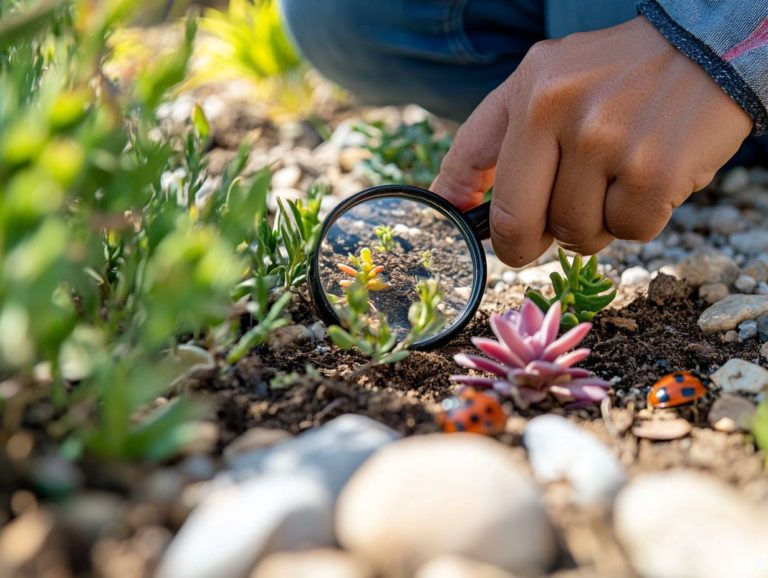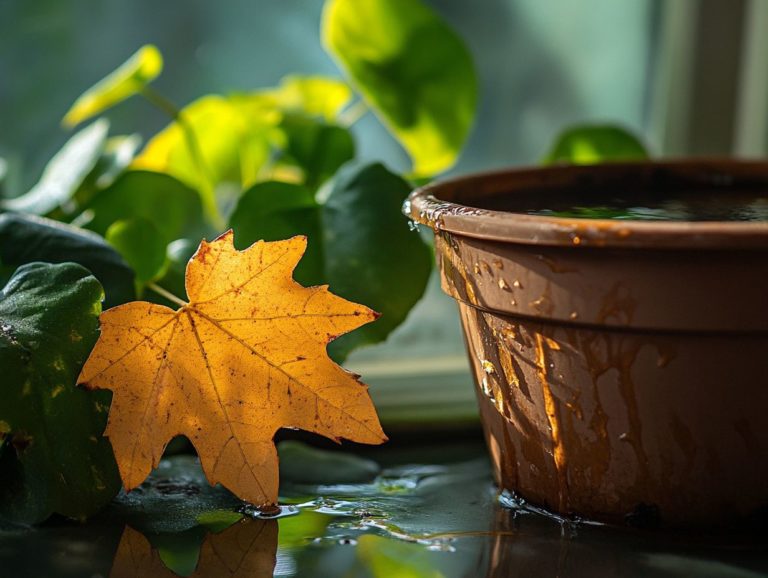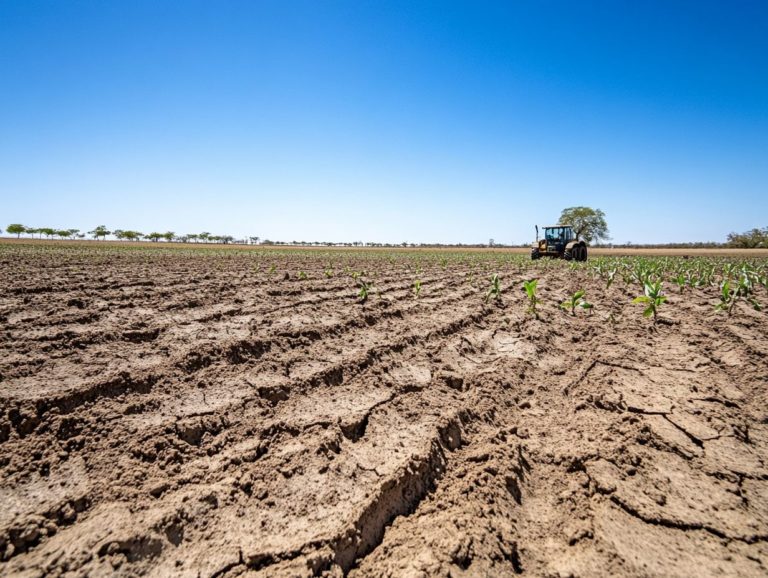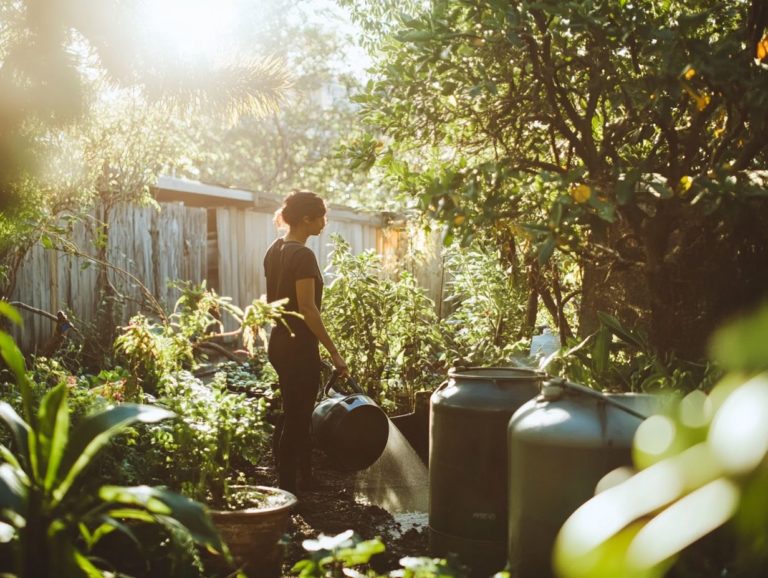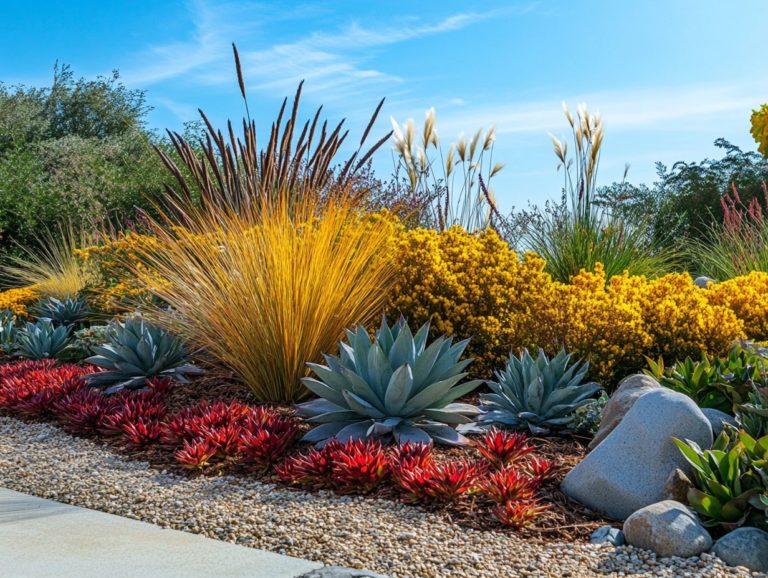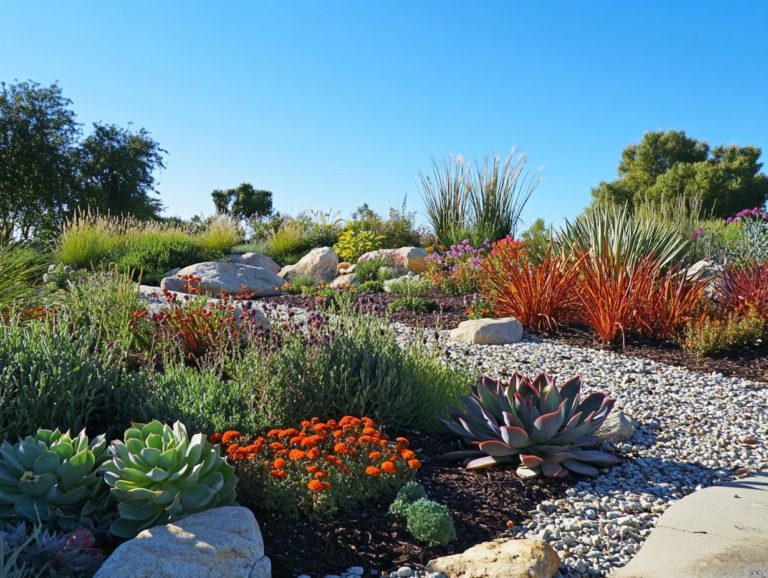How to Create a Sustainable Drought Garden?
Drought gardens present a sophisticated solution to the growing challenge of arid conditions, blending aesthetics with sustainability.
In this exploration, you will uncover what a drought garden truly is, the myriad benefits it offers for both the environment and your personal sanctuary, and how to select the ideal plants for your space.
From the initial planning and design to ongoing maintenance, you ll find valuable tips and strategies to create a flourishing oasis that conserves water and endures dry spells with grace.
Embark on a journey to cultivate a resilient garden that not only survives but thrives in challenging climates.
Contents
- Key Takeaways:
- Understanding Drought Gardens
- Benefits of Creating a Drought Garden
- Choosing the Right Plants for a Drought Garden
- Designing and Planning Your Drought Garden
- Maintaining Your Drought Garden
- Troubleshooting Common Issues
- Frequently Asked Questions
- What is a drought garden?
- How do I choose the right plants for a sustainable drought garden?
- What are some key factors to consider when creating a sustainable drought garden?
- How can I conserve water in my drought garden?
- Do I need to sacrifice aesthetics for a sustainable drought garden?
- How do I maintain a sustainable drought garden?
Key Takeaways:
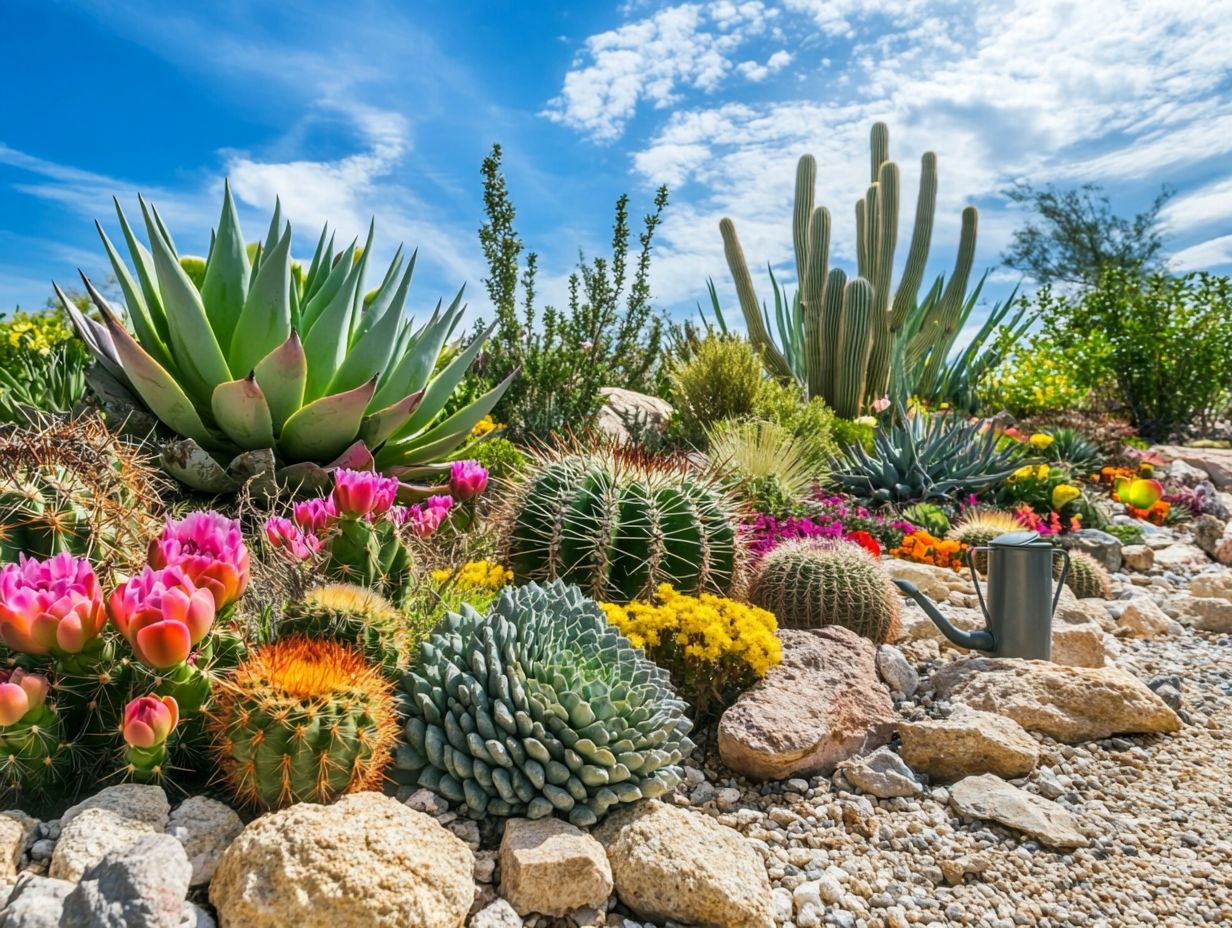
- Choose drought-tolerant plants and design a sustainable watering system to create a resilient and environmentally friendly garden.
- Consider environmental and personal benefits when creating a drought garden, such as conserving water and reducing maintenance costs.
- Maintain your drought garden with proper care and troubleshooting techniques to ensure its long-term success and beauty.
Understanding Drought Gardens
Drought gardens are carefully designed spaces that focus on drought-tolerant plants and water-efficient strategies. By learning how to create a wildlife-friendly drought garden, you can empower yourself to cultivate sustainable outdoor spaces that flourish even in challenging climate conditions.
These gardens use creative landscaping techniques. They conserve water, enrich the ecosystem, and require less maintenance.
What is a Drought Garden?
A drought garden is a sophisticated garden design that emphasizes the use of drought-tolerant and native plants. To learn how to plan a drought-resistant garden layout, you can minimize water usage while championing sustainable gardening practices.
These gardens play a crucial role in conserving water, enhancing soil health, and cultivating a resilient ecosystem capable of enduring extended dry spells. By employing techniques like hydrozoning grouping plants that need similar amounts of water together and utilizing organic material that improves soil to enrich soil structure and nutrient availability, your garden will flourish even under challenging conditions.
Using organic mulch strategically helps retain moisture while regulating soil temperature, providing optimal benefits for root systems throughout the changing seasons. To further improve your garden’s resilience, consider learning how to enhance drought resistance in existing gardens. With exemplary plant choices such as lavender, succulents, and native grasses, a drought garden showcases both beauty and functionality, making it a visually stunning and environmentally responsible choice for your outdoor space.
Benefits of Creating a Drought Garden
Creating a drought garden opens the door to incredible benefits, including water conservation, lower maintenance demands, and a beneficial impact on the environment. It s an astute choice for homeowners eager to enhance their outdoor spaces sustainably.
By integrating drought-tolerant plants, these gardens not only flourish in arid conditions but also foster biodiversity and support healthy ecosystems.
Environmental and Personal Benefits
The environmental benefits of a drought garden are noteworthy, including substantial reductions in water usage and the encouragement of local wildlife. On a personal level, you may enjoy lower maintenance costs alongside a more aesthetically pleasing outdoor space.
Beyond these advantages, such gardens contribute to improved soil health by promoting deeper root systems. This allows plants to tap into underground moisture while also preventing erosion. The result is heightened biodiversity, creating inviting habitats for pollinators and other beneficial creatures.
As environmental experts like Ci ra Cree emphasize, “Drought-tolerant landscapes not only conserve water but also enhance the ecological balance.”
Becca Cullum-Green points out the therapeutic benefits of native plants, suggesting that “surrounding ourselves with these natural elements can significantly reduce stress and elevate mood.” The aesthetic allure of these plants not only beautifies your landscape but also fosters a deeper connection to nature, enriching both your personal well-being and the local ecosystem.
Start planning your drought garden today and learn how to maintain drought-resistant landscapes as you join the movement toward a beautiful, sustainable future!
Choosing the Right Plants for a Drought Garden
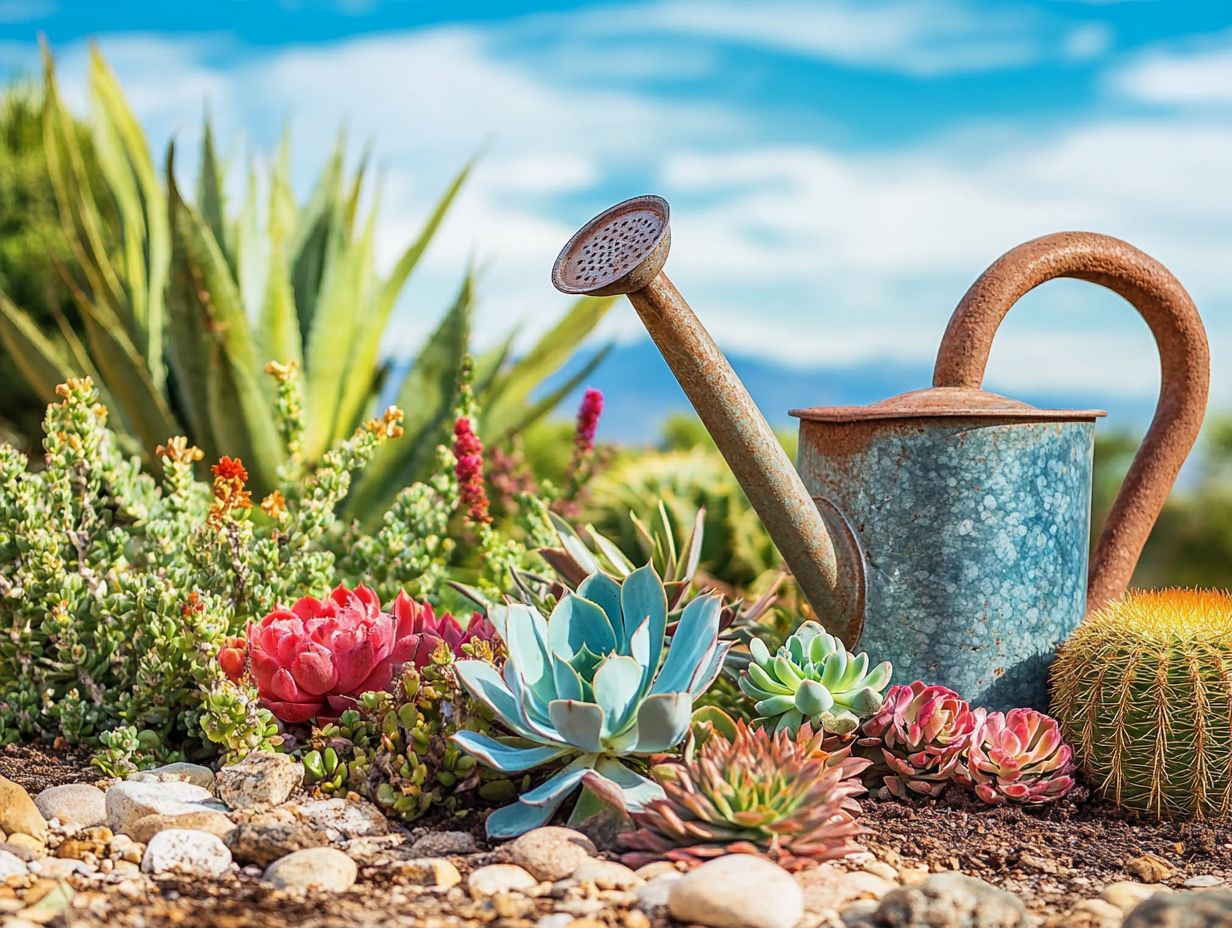
Selecting the right plants for your drought garden is essential for designing a drought-tolerant garden that creates a thriving landscape in arid conditions. This approach promotes soil health and ecosystem stability.
By prioritizing drought-tolerant and native plants, you ensure resilience against climate fluctuations while enhancing the aesthetic appeal and sustainability of your garden.
This thoughtful approach transforms your space into a beautiful sanctuary that flourishes even in challenging environments.
Drought-Tolerant Plant Options
When you plan a drought garden, selecting drought-tolerant plants is crucial. For more information, check out the essentials for starting a drought garden. Consider options like succulents, native grasses, and flowering perennials.
These plants thrive in low-water conditions and are perfect for eco-friendly landscaping. They infuse your garden with vibrant color and texture.
Additionally, they play a vital role in conserving water, especially in arid regions such as Arizona. Take the stunning Agave Americana, for example; its striking rosette form requires minimal irrigation once established.
Then there s Apache Plume (Fallugia paradoxa), a delightful shrub that withstands the harsh summer sun and attracts pollinators.
Experts like Ray Brosnan emphasize the importance of selecting plants that adapt to local climates. This choice reduces maintenance while promoting biodiversity.
By incorporating these resilient species, you can create a sustainable environment that thrives even in drought conditions.
Factors to Consider in Plant Selection
When selecting plants for your drought garden, consider factors like soil conditions, maintenance requirements, and the overall climate.
Your specific soil type whether sandy, clay, or loamy can dramatically influence which plants will flourish.
Assess how well your soil retains water, especially in arid conditions. This is crucial for cultivating a healthy ecosystem.
Prioritize plants that grow naturally in your region. Native species are well-suited to local weather and attract pollinators.
Fostering compatibility among diverse plants enhances both the aesthetics and functionality of your garden.
Create a harmonious space that promotes biodiversity while minimizing resource needs.
Designing and Planning Your Drought Garden
Designing and planning a drought garden requires thoughtful consideration of several key elements. This includes selecting the right plants, integrating hardscaping features, and implementing strategies to promote biodiversity along with efficient water-wise practices.
This approach cultivates a cohesive and sustainable landscape that flourishes even in low moisture conditions.
You can use techniques like grouping plants with similar water needs and permeable hardscaping to optimize water resource management.
These techniques simultaneously elevate the aesthetic appeal of your outdoor space.
Factors to Consider in Design
When designing a drought garden, consider factors such as your local climate, available space, soil type, and desired landscape features.
Understanding the local climate is crucial, as it dictates which plant species will flourish. Recognizing your soil’s characteristics influences water retention and nutrient availability.
Embrace eco-friendly practices like mulching and incorporating native plants to enhance biodiversity.
Promote beneficial insects and wildlife in your garden with strategies like rain gardens and xeriscaping.
These methods conserve water and ensure your sustainable landscaping beautifies your space while positively contributing to the ecosystem.
Start transforming your garden into a drought-resistant paradise today! Be sure to explore what to consider before starting a drought garden and choose the right plants now to create a sustainable oasis.
Creating a Sustainable Watering System
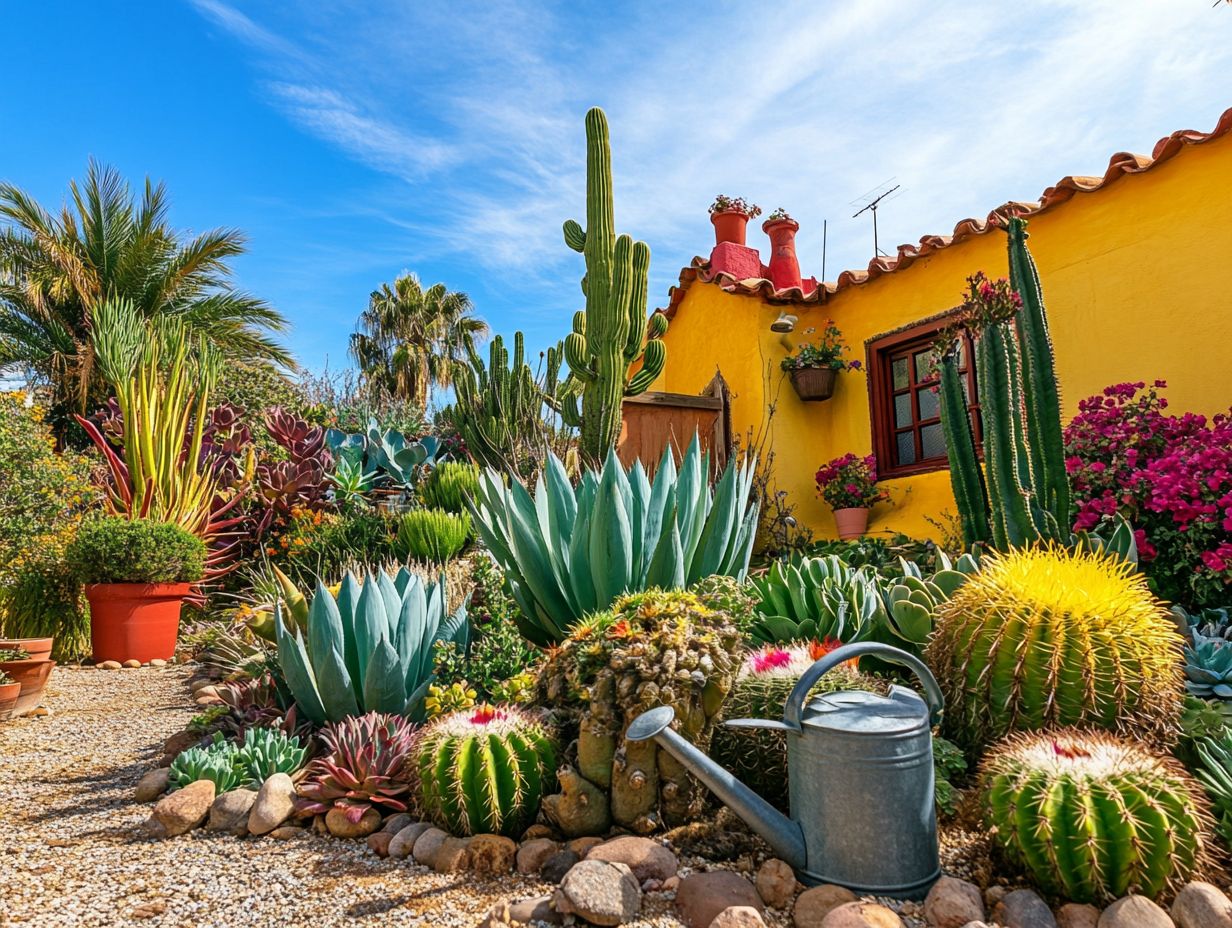
Establishing a sustainable watering system is essential for nurturing a drought garden. You can achieve this by employing methods such as drip irrigation, a watering method that delivers water directly to the roots of plants, and rainwater harvesting. To further enhance your garden, consider learning how to design a drought-resistant landscape. These methods minimize water waste and promote the efficient use of resources.
By implementing these techniques, you ensure that your plants receive the hydration they need while conserving precious water supplies. Incorporating organic mulch serves a dual purpose: it retains soil moisture and enhances soil health as it decomposes. This natural barrier significantly reduces evaporation and curbs weed growth, allowing more water to reach the roots where it matters most.
To further amplify your water conservation efforts, consider choosing drought-resistant plant varieties. When combined, these strategies create a resilient garden ecosystem that can thrive even under challenging conditions.
Maintaining Your Drought Garden
To keep your drought garden flourishing, regular maintenance is crucial. Focus on eco-friendly practices that not only support plant health but also minimize water usage. Learning how to use drought gardening principles in landscaping ensures a sustainable and stunning landscape throughout the year.
Implementing techniques such as mulching and careful pruning can greatly enhance moisture retention and foster robust growth.
Tips for Keeping Your Garden Thriving
- Proper mulching
- Regularly monitoring soil moisture
- Thoughtfully selecting companion plants that enhance your garden’s overall health
By fostering a diverse ecosystem, you can effectively support pest management while allowing resilient plants to flourish. Maintaining healthy soil through organic amendments and steering clear of chemical fertilizers promotes robust root development and helps keep harmful pests at bay. Seasonal care, like pruning during the cooler months, stimulates growth and wards off diseases.
Utilizing drip irrigation systems maximizes water efficiency, providing plants with precisely what they need. These strategies create a harmonious balance, ensuring that your drought garden remains a vibrant and low-maintenance haven, even in the hottest months.
Troubleshooting Common Issues
Identifying and addressing common issues in a drought garden is essential for maintaining the health of your plants and ensuring your landscape stays vibrant. Addressing this process requires quick ways to fix problems and understanding environmental conditions.
By consistently monitoring your plants and soil, you can effectively mitigate potential problems and foster a resilient garden ecosystem that thrives even in challenging conditions.
Identifying and Addressing Problems
Recognizing signs of stress in your plants and understanding common garden issues is crucial for effectively managing a drought garden. This knowledge gives you the power to take timely corrective actions.
Being aware of these signs can significantly impact the health of your plants and soil, especially as your garden faces challenges like reduced rainfall and rising temperatures. You might notice wilting leaves, slow growth, or discoloration clear indicators that your plants are struggling. Soil erosion and nutrient depletion are common problems too.
To tackle these challenges, consider employing eco-friendly methods such as mulching and drip irrigation. These practices not only help conserve moisture but also foster a healthier ecosystem, ensuring the vitality of both your plants and soil during tough conditions.
Frequently Asked Questions
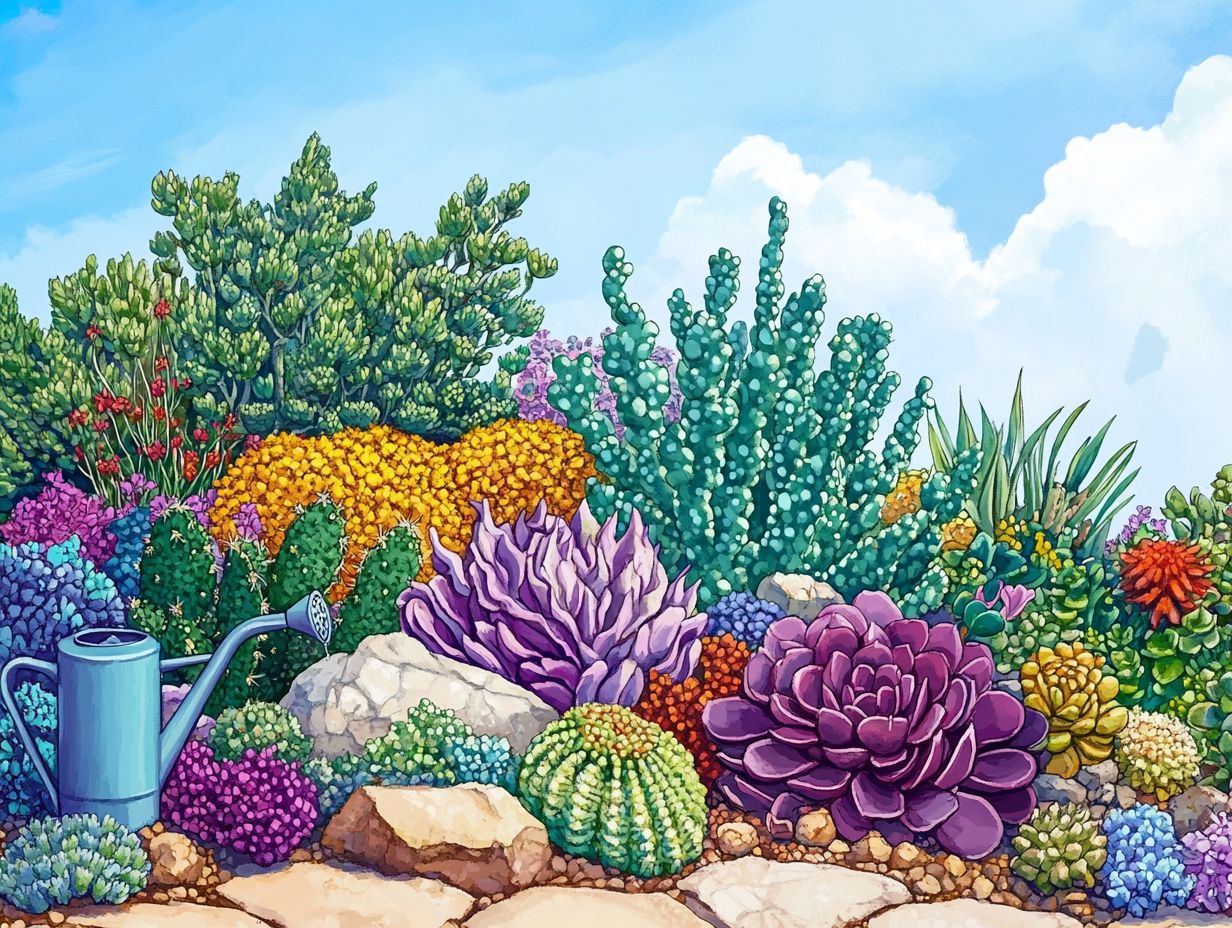
What is a drought garden?
A drought garden is a type of garden that is designed to thrive in dry conditions with minimal water usage. It typically consists of plants that are naturally adapted to drought or have low water requirements.
Ready to transform your garden into a drought-resistant delight? Start today!
How do I choose the right plants for a sustainable drought garden?
Choose plants that are native to your area. They are better at surviving dry conditions.
Look for species with small leaves, deep roots, or fuzzy and waxy surfaces. These features help plants retain water.
What are some key factors to consider when creating a sustainable drought garden?
Consider important factors like your local climate, soil type, and amount of sunlight. These elements influence the types of plants you can grow and how much water they will need.
How can I conserve water in my drought garden?
There are many ways to conserve water in your drought garden. Use mulch to retain moisture and install a drip irrigation system.
Group plants with similar watering needs together. You can also collect rainwater in a barrel for watering your garden.
Do I need to sacrifice aesthetics for a sustainable drought garden?
No! You can absolutely create a stunning garden that thrives on minimal water.
Many drought-tolerant plants offer a variety of colors, textures, and sizes, allowing for an aesthetically pleasing garden.
How do I maintain a sustainable drought garden?
Regular care is key to keeping your garden healthy. Monitor soil moisture and remove weeds that compete for water.
Prune back plants to promote efficient water usage. Regularly review and adjust your watering schedule as needed.
Start planning your drought garden today for a beautiful, sustainable outdoor space!

